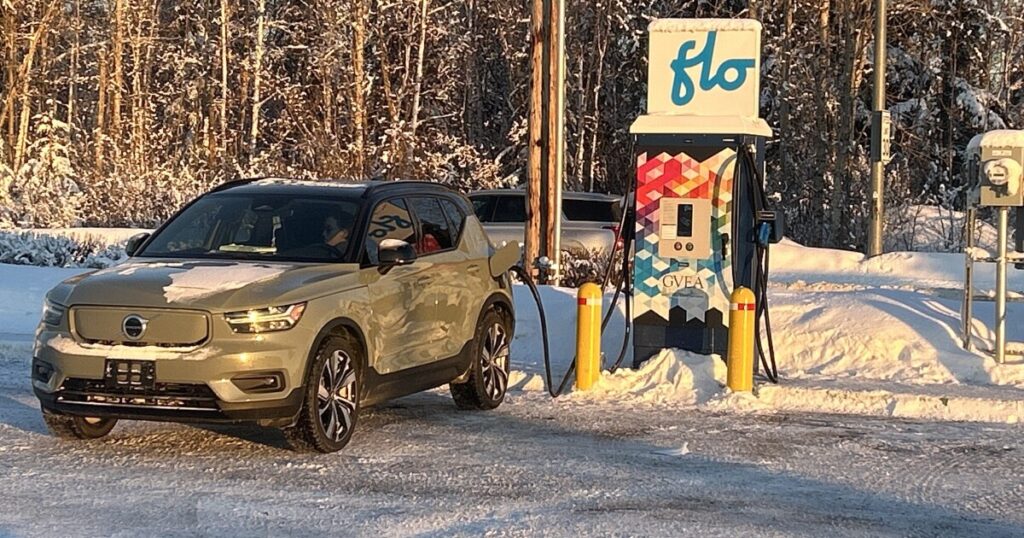The ambitious initiative to enhance electric vehicle charging infrastructure in Alaska’s Interior is facing a significant delay. Recently, the Trump administration decided to put a hold on a $5 billion federal program aimed at promoting clean energy infrastructure, creating uncertainty for local projects.
Electric vehicle (EV) owners like Kirby Hobley are feeling the effects of this delay. Hobley, who drives an electric Volvo, often relies on one of the limited fast-charging stations available in Fairbanks, specifically at the Golden Valley Electric Association parking lot. While many EV owners opt for home charging, which is time-consuming, fast-charging stations like the one Hobley uses provide quicker solutions. However, these stations are scarce and shared among approximately 150 EV users in the area.
“I really like my EV, but that the infrastructure is not here for it makes it much more stressful to have it,” Hobley expressed. “But I don’t want to go back to something that just, like, pollutes.”
Although Hobley’s Volvo is powered by electricity from Fairbanks’ grid, which relies heavily on fossil fuels, experts argue that EVs are still more efficient and environmentally friendly compared to gasoline-powered vehicles.

Photo by Shelby Herbert/Alaska Public Media
EV Adoption Outpaces Infrastructure in Alaska’s Interior
As Alaska’s demand for electric vehicles is projected to increase by as much as 60% annually, the existing infrastructure struggles to keep up, especially in the Interior. While Anchorage and Juneau have better support systems for EVs, places like Fairbanks lag far behind. Many users have reported difficulties with charging stations on the PlugShare app, citing issues such as snow blocking access or needing apps that are unusable due to poor cell service. Hobley’s experiences reflect these frustrations.
“I mean, it’s pretty bleak,” Hobley noted. “Like, whatever company they have at the Three Bears — their fast chargers don’t work. There have been times when I’ve had to get towed to Anchorage because, otherwise, I would have been sitting there all night.”
NEVI Program Faces Setback
A collaborative plan involving the Alaska Energy Authority and Fairbanks’ transportation planners aimed to roll out nearly 100 new EV charging ports across Fairbanks and along major highways. This initiative, supported by $52 million from the National Electric Vehicle Infrastructure program (NEVI), was set to kick off this summer. However, the Trump administration’s decision to review the NEVI program has put these projects on hold.
Jackson Fox, overseeing Fairbanks’ transportation efforts, voiced concerns about the project’s future, stating, “We’re worried about whether or not we’ll actually get a federal reimbursement for that work. There’s a lot of uncertainty, and we are waiting on further direction and guidance from our Federal Highway Division office in Alaska as to the risks moving forward.” The Federal Highway Administration has yet to clarify the situation, though a memo indicated upcoming updates to align with current priorities.
Stakeholders Remain Optimistic
Tim Leach, deputy director of LaunchAlaska and an EV owner, emphasizes the importance of modernizing Alaska’s infrastructure. “A lot of our folks here in Alaska are really interested in self-reliance,” he said. “This is a topic that is near and dear to many, but we need to make sure that we have publicly-available charging infrastructure to enable that consumer choice.”
Despite the infrastructure challenges, Leach notes cost benefits for EV owners, who save on fuel expenses and can even use their vehicles to power their homes during outages. “There’s actually the ability to then send the electrons back through the wires in the other direction,” Leach explained. He highlighted the potential for EV batteries to support homes or small businesses during grid failures, a frequent issue in Alaska’s harsh climate.
With NEVI funding in limbo, Jackson Fox remains hopeful about finding alternative resources to continue the project. “I’m using the word ‘pause’ right now because I have hopes that we can get this back on track,” he shared. “So, provided we’re using a different funding source, we might still be safe to move forward. But, again: we feel some risk.”
Original Story at fm.kuac.org
